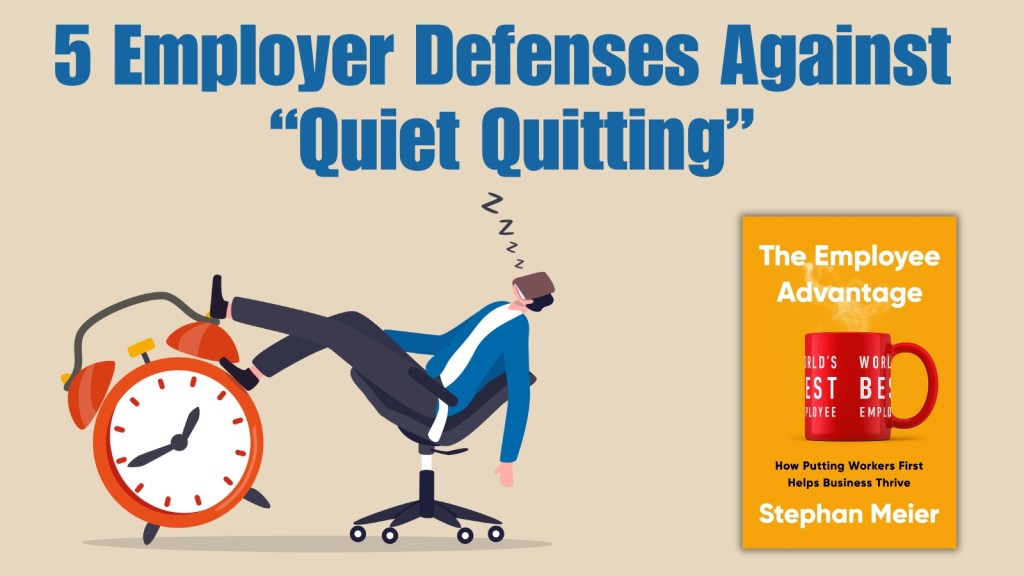The Employee Advantage
Why bonuses won’t motivate your employees — and four other defenses against “quiet quitting”

You’ve likely heard about “quiet quitting,” when a worker puts in the absolute minimum amount of effort required to keep their job. This so-called phenomenon has been in the news recently, but it’s hardly new, says Stephan Meier, the James P. Gorman Professor of Business Strategy and the Chair of the Management Division at Columbia Business School. In his new book, The Employee Advantage: How Putting Workers First Helps Business Thrive, he notes that only about a third of employees in the U.S. are engaged at work — a number that has remained relatively stable for the past 20 years.
So how do you get this large segment of the workforce engaged again? Your first thought is probably to pay them more, and yes, financial stability does improve worker performance. In fact, a study of manufacturing workers in India found that simply paying workers the same but more often — and thereby mitigating some of their financial anxiety — increased their productivity by 7%. In another example, a Fortune 500 company increased its own minimum wage and found that a one dollar per hour increase boosted productivity by almost 6%. However, money only goes so far to motivate employees.
To truly build an employee-centric culture, and in the process create a more productive, innovative, and valuable company, you need to think bigger, says Meier. Below, he shares five tips to reaping the employee advantage.
- Monetary incentives can fall flat — or even backfire.
Though we gleefully imagine how a sudden influx of cash would radically improve our life, that’s more of a fantasy than a reality. Studies show that people acclimate quickly to more money — even when it’s as significant as winning the lottery. That’s a problem for employers who want to use a pay raise to, say, offset the burden of a long commute. After an initial bump in happiness, employees will revert back to their baseline dissatisfaction. In fact, a comprehensive meta-analysis involving more than fifteen thousand individuals found a notably weak correlation between wages and job satisfaction.
To make matters worse, financial incentives can decimate people’s own intrinsic motivation. For example, a German retailer introduced a bonus for employees: for every three months of perfect attendance, they’d receive 60 euros, a potential for 240 extra euros a year. The scheme failed miserably, with those who were offered the incentive racking up five absences more per year than those who weren’t offered it. As Meier notes, “Monetary incentives or pay-for-performance policies signal an underlying distrust and can therefore backfire.”
- Building an employee-centric culture means finding the right employees.
Zappos.com makes a seemingly ludicrous proposition to its new hires: After they’ve already been interviewed, hired, and trained, the company offers them $2,000 if they leave the company. This counter-intuitive incentive reflects a bold commitment to the idea that new hires must be as excited about their new employer as their new employer is about them. “The selection, on both sides, has to go beyond the skills required for the job or just the job description,” writes Meier. “Whether the corporate culture is a good fit for the job applicant is hard to tell from the job description.”
The cofounder of Southwest Airlines put it slightly differently. He said, “Select for attitudes, train for skills,” meaning that an employee could be taught to perform their duties much more easily than they could be taught to be the kind of happy, engaging, helpful person who customers want to be around. As part of its own hiring process, Southwest Airlines asks applicants to tell a joke. It’s a small feature, but it reflects a philosophy that prioritizes cultural fits over just experience and degrees.
- Your employees likely want to stay with the company — if they see a path for advancement.
Especially in low-wage jobs, turnover at most companies is high, which diverts much-needed resources into rehiring and training new workers. However, that’s not the case at Costco, which pays substantially more than its major competitor, Walmart, offers health insurance benefits, and, crucially, provides ample career opportunities for its employees. Contrary to what you may think, many low-wage workers would like to stay with their employer, and that last factor — the prospect of upward mobility — is one of the most important factors for retaining them, according to researchers at Harvard Business School.
At Costco, the strategy seems to be paying off. Its turnover rate is just 17% overall (and 6% after one year of employment), which is less than half of what Walmart’s is. Meanwhile, according to the company’s CFO, in 2019 its shrinkage (the industry term for shoplifting and employee theft) was 13.5 times lower than the industry average, saving the company about $2 billion. “If employees (even on the front line) feel respected and appreciated,” writes Meier, “they do not want to leave.”
- Want to innovate? Your on-the-ground employees likely have suggestions.
Toyota has faith in its employees — about $15,000 per minute worth of faith, to be exact. In its factories, Toyota has hung andon cords that workers are expected to pull whenever they see a problem in the quality or a process that needs fixing. If said issue isn’t resolved within a couple of minutes, the assembly line stops completely, which costs the hefty sum mentioned above. Needless to say, imbuing every worker with this kind of power is a risk, but one that demonstrates the auto giant’s faith in its workforce.
By giving employees such substantive autonomy, Toyota demonstrated its trust in them. In return, it asked for their assistance in streamlining and improving operations. To allay their concerns about suggesting improvements that would make themselves redundant, the firm committed to a no lay-off policy — and stuck to it even when capacity at the end of the 1980s dropped to 65 percent. The results have been impressive. In one Kentucky plant, assembly plant workers made eighty thousand improvement suggestions in one year. Ninety-nine percent of them were approved. To implement such a strategy, Meier writes, “Supervisors need to dramatically change from a command-and-control structure to a team-based approach where decisions are delegated down to the team level.”
- Work may not always be enjoyable — but under the right circumstances, it’s deeply satisfying.
Many employers operate under the assumption that their workers must be forced, cajoled, and tricked into being productive. While that may be the case at certain companies (likely because of the boss’s adversarial attitude toward their employees), it’s important to remember that working gives many people purpose in life.
In 2017, researchers selected over 700 people from a refugee camp in Bangladesh and divided them into two groups for an eight-week period. One group earned a salary by documenting other refugees’ activities in the camp. The other got the same salary but were only required to answer a weekly survey. Those who worked enjoyed mental health benefits four times higher than the nonworking group, and 69% said they’d be willing to work an extra week for zero pay. “If work is just a chore and wage compensation is the only benefit, then people would want to be in the second group,” writes Meier. “But that’s not what the researchers found.”
―Adam Grant, #1 New York Times–bestselling author of Think Again
In an ever-shifting work landscape, leaders can no longer ignore their most overlooked stakeholders—their employees.
In The Employee Advantage, behavioral economist Stephan Meier explains why organizations must value their employees as much as—if not more than—their customers: those that pivot toward an employee-centric model will be more profitable, innovative, and appealing to top talent.
The good news? You don’t need to start from scratch. The customer-centric tools that give you a competitive advantage can be repurposed to focus on employees.
Through case studies of Fortune 500 companies like Costco, DHL, and Best Buy as well as smaller organizations, you will learn:
- Why employees care about more than just money when it comes to their jobs—the same way customers care about more than just price
- What two mindset shifts are essential to becoming an employee-centric workplace
- How improving your employee experience will benefit your business and your bottom line
The future of work is human-centric. The companies that win in the marketplace will be those with the best employees. To get and stay ahead, businesses must embrace the employee advantage.
